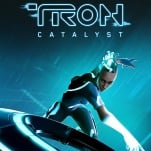Metal Eden Should Let Go and Embrace the Flow

POV: You’re a droid, your existence is illegal, you have several guns, and there’s a sexy male voice droning about death in your ear at all times. This is Metal Eden, the new game from Polish studio Reikon Games, and it’s a slick first-person shooter with some interesting ideas. And it all starts with a firehose spray of information about your character Aska’s background and the messed-up future she’s unlucky enough to live in.
After the opening cutscene explains the failed experiment responsible for Aska’s creation, you are literally dropped into the game guns blazing. It’s a dizzying sprint down endless shiny metal corridors with charming narration from your creator. (I’m actually smitten with Nexus solely because of his voice actor’s performance—someone give this guy a raise!). You shoot at enemies and they explode, which is very good and fun and satisfying. But as you’re running and shooting and absorbing that this game is about constant movement, and that you really gotta go go go, the camera freezes and you’re ripped out of the game. What? Oh, it’s time to learn a new mechanic. Oh, it’s time for a new cutscene.
What makes these pauses so frustrating is how gripping the gameplay itself is. In addition to the traditional dashing and shooting, the game’s hallmark mechanic is your ability to absorb enemy cores and use them as either explosive projectiles or crazy enhancements to your melee attack. The core absorption is on a cooldown (which can be reduced through the skilltree) to keep you moving and shooting, with item pickups that set that cooldown to zero. The variety of enemies thrown your way forces you to balance every mechanic of the game, from grappling across platforms to wall running to hurling core bombs and melee attacking when your gun overheats. At its best, the game is exhilarating.

But the rhythm you establish playing through Metal Eden crumples when the game screeches to a halt every other minute. You can’t really get into anything like a flow when there’s a steady sequence of arbitrary signposts. Freeze-frame tutorials with written instructions and demonstrative gifs are counterintuitive in such a fast-paced game; the tutorial segments would have been much smoother had they instead been slow-motion events where the game doesn’t progress until you complete input prompts. Even when you make it past the tutorials, you’re still subjected to in-game cutscenes where the next boss epically powers up—meanwhile you’re reeling from how hard the camera just cut away from your control.
There isn’t really room for respite, no moment to breathe. When you’re playing, you’re moving, and sometimes Nexus is even telling you to hurry up. The movement feels fantastic; you have a jump and a limited hover, a wall jump on certain designated surfaces, a grappling hook, and a zipline at your disposal. In levels where you’re facing waves of enemies, zipping around the terrain as your robot foes scramble to keep up is thrilling. Pickups are waiting to be grabbed as a reward for your zoomies, too.
-

-

-

-

-

-

-

-

-

-

-

-

-

-

-

-

-

-

-

-

-

-

-

-

-

-

-

-

-

-

-

-

-

-

-

-

-

-

-

-









































